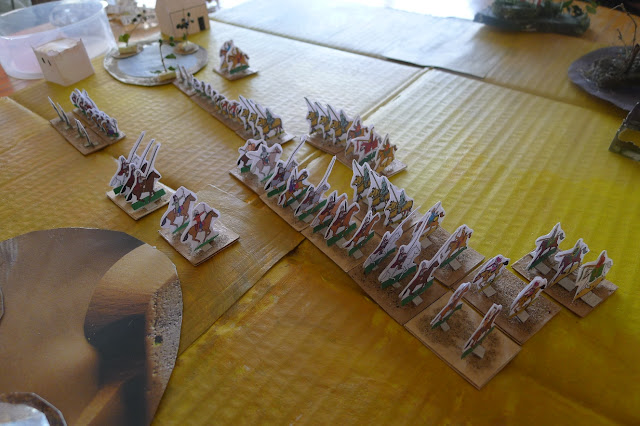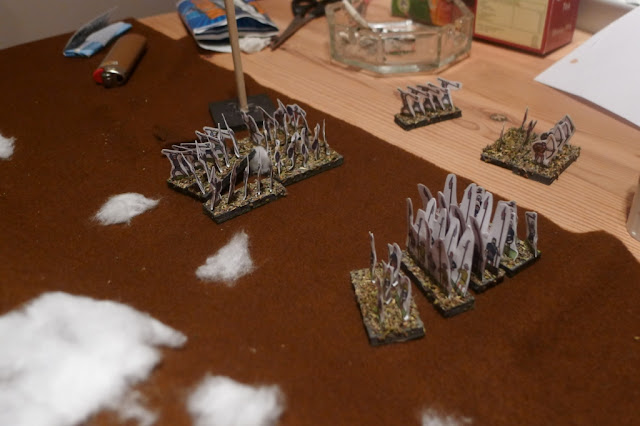So this is it, the Grand Finale! The two empires meet on Crete, an island the two generals know too well. Three times before their armies have clashed near Samaria, the famous gorge which by now has had enough human flesh to feed an army of crows and scavengers.
After well-thought advice from historian Ermokratis, the greeks have spent some time at Hersonissos, a beautiful town in the north of Crete. The morale boost has been particularly evident on the varangians who were not raised with sunshine and beaches in plenty. Refreshed (and a little bit hangover) the byzantines march the long trek from Hersonissos to Samaria, the gorge near which Saladin has camped the night before. Both generals know that this will probably be their last battle against each other. This campaign has dwindled the coffers of both empires and both Palaiologos and Saladin need to return to the royal courts and tidy internal matters (a peasant revolt or two). Thus, the battle is a matter of honour. Both leaders want to win for their personal ambition, they want to go home and announce victory despite the cost. On to the day's work then.
 The byzantine double-headed eagle flies high as the greek general deploys his troops. A mix of Pachenegs and kavallarioi on the left, heavier horsemen (along with the greek general) on the right and all the infantry to maneuver in and around the gorge. His army is fully reinforced and battle-ready.
The byzantine double-headed eagle flies high as the greek general deploys his troops. A mix of Pachenegs and kavallarioi on the left, heavier horsemen (along with the greek general) on the right and all the infantry to maneuver in and around the gorge. His army is fully reinforced and battle-ready.
Saladin deploys his forces with a different plan. Not as balanced as his enemy's, his line has archers and some cavalry on the right, some light infantry going for the gorge and most of his cavalry on the left.
Saladin advance his left, the bulk of his army. A solid group of five units moves forward to meet the greeks, while the rest of the egyptians are still far back.
Palaiologos makes his move as well. His cavalry on the right forms a line and
marches forward. Behind the hills, a unit of Pachenegs rushes to
reinforce the right wing. The byzantine heavy infantry is slowly
negotiating the gorge.
It seems not long now... The greek right is quickly rushing forward with the varangians close behind. The Pachenegs are trying to arrive on time.
The lines are a stone's throw away from each other. Now the skutatoi spearmen are in the frontlines behind a unit of seljuk psiloi and the varangians to the right.Two units of Pachenegs approaching the greek right wing. Was that Palaiologos' plan?
The arabs' right wing seems to be far from the action. Has Saladin made a mistake? A unit of berber light cavalry is left behind to reinforce any wing in need.
As usual, this battle is turning out a fight against time. The egyptian general managed to get his units on the right in a good position but are they on time? His bowmen are heading towards the gorge and his cavalry is facing the greek horsemen protecting the camp.
On the byzantine right time is standing still. The lines of cavalry are ready but noone is making the final charge. In the gorge the sudanese bowmen are taking positions to shoot at the cumans and the skutatoi. On the far side the odds are even. Four horse units are facing each other.
Bodies are rolling down the hills as the sudanese shoot down the cumans who rout. With a stroke of luck the arabs gain a small and temporary advantage in the gorge. Now the greeks have to react quickly.
Battle is joined! Palaiologos orders the charge and the right wing rushes forward with the greeks shouting their emperor's name! The two generals are engaged very close to each other and Saladin is finally pushed back along with another of his units, while Palaiologos urges his men to grasp victory! In the center the Pachenegs valiantly enter the gorge to support the left side.
Saladin regroups his troops and he can't avoid feel a chill down his spine. If he falls, the campaign is over and Palaiologos is the winner. The greeks rearrange their lines as well and the Pachenegs who have been moving all over the place now seem to approach the right wing and reinforce it. The skutatoi are left alone to guard the passages in the gorge.
A mix of emotions is carved on the faces of the men who fight and die. Anger, desperation, fear and most of all constant bewilderment flash quickly in every face, including the two generals. Now comes the time of the varangians. They simply move forward swinging their axes at Saladin and the arabs try to keep them at bay. Palaiologos prepares for another charge with his guard.
Another panoramic view of the battlefield and the battle is raging. The sudanese archers approach the center to keep the Pachenegs in check. Still noone has the upper hand.
Turn of the tables. Now the gorge becomes the prize as a skutatoi unit defends the passes against two egyptian bow units while Saladin's light-foot jarwajaraya stand against a unit of Pachenegs on the craggy ground.
The Pachenegs' horses can't handle the rocks and javelins, and flee. Now the hilly center seems open to Saladin's troops for the taking.
The jarwajaraya quickly charge the greek flank and cut down a unit of Pachenegs! Palaiologos gets news of his left collapsing and feels panic creeping in.
The byzantine army is not giving up. The Pachenegs are back to aid the flank and the skutatoi retreat to defend the gorge farther back.
This is it! The final charge of the egyptians, of the battle, of the whole campaign. All the men (greeks, egyptians, cumans, serbs, albanians, seljuks, norsemen, muslims, christians and pagans alike) take a breath and get ready for the final push which comes from Saladin's army. "Allahu akbar!" and "o stavros nika!" are heard all over, and men and horses are lost in a cloud of steel, dust and blood. The whole wings are now engaged with a strong advantage of Saladin on his right, a jarwajaraya unit surrounding the greek psiloi.
DONE. The varangians are cut down by Saladin's personal guard and the egyptian general, now master of Crete, tramples on the norsemen's bodies. Palaiologos can't believe his beloved elite infantry are no more and starts regrouping his troops for retreat. Crete is lost for the greeks but the general is already thinking of his own head when he brings the news back to Constantinople. He nods a respectful acknowledgment to Saladin and his men, and rides away. There is still work to do for the empire and he must keep his head... clear.
Saladin watches his former enemy ride away and knows he doesn't need to pursue. The greeks aren't coming back to Crete soon. As the sun is setting, the byzantine dead are seen scattered all over the battlefield but the arab general intends to allow the greeks to gather their dead. They have earned much more than that. His mind settles to a grim satisfaction which he hopes not to forget as he keeps on forging egypt's destiny.



































































